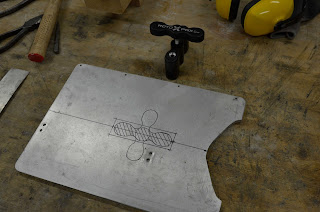Geologically, Lanark County is basically distinguished by limestone bedrock in the east and south (think of the Burntlands area just east of Almonte) and Precambrian Shield in the west and north (Mt. Pakenham to Lanark Highlands to Muskoka and beyond). The line between the two regions is visible all the way from Champlain Lookout in Gatineau Park: on the horizon you can make out where the Shield rises from the limestone plain just west of Almonte and forms a ridge running up to Pakenham where the ski hill is located. Behind in the distance is the highlands region. Of course, this is only part of the boundary between the geologies but it's a pretty obvious one to see and a good place to start.
What's also interesting about this ridge is it was the far shore of the Champlain Sea that filled the Ottawa Valley after the last ice age melted around 12,000 years ago. Where previously there was some 3km of ice stacked onto the Valley, all of a sudden (geologically speaking) there was a vast inland sea connected to the Atlantic via the St. Lawrence valley. Vestiges of former beach areas, raw material created by glacial erosion and now marked by large sandy ridges areas along roads such as the Old Perth Road out of Almonte, can be seen today. Imagine seals, walruses, gulls, and other wildlife basking on these ridges the next time you're motoring down this dirt road!
What does all this have to do with the Tatlock Quarry? Well, the boundary between the shield and limestone bedrock regions is rife with protruding marble formations that resulted from ancient geological processes metamorphosing limestone beds through heat and pressure. You can see the bedding layers of the marble in cross-section at the Tatlock Quarry. Striations and darker bands clearly show how the original limestone layers were gently folded and thrust upward as they transformed into marble over time.
Much of the marble in Lanark County seems to be highly granular and poorly consolidated compared to the fine-grained white marbles from places such as Cararra in Italy. You're going to have a bad time trying to carve an old-world masterpiece from a Tatlock Quarry block. I know a few local stone carvers who've had some success with the odd bit of marble found in the area, but for the most part it seems the main value of the deposits is industrial use. For instance, Omya operates the Tatlock Quarry (and others) to obtain high quality white filler use in paints, plastics, and toothpaste.
Fortunately the marble plays a more important role in Lanark County. First, consider that in the areas of Canadian Shield, soils are thin and acidic. Pine trees love this kind of ecology and, coupled with the relatively warm climate of eastern Ontario and easy water access, it's no surprise that Lanark County was once one of (if not the) richest sources of squared pine logs in North America. In fact, Lanark and surrounding counties supplied some 12 billion squared timber logs that were floated down the Ottawa River and sent back to Great Britain and Europe since the early 1800s. (To be even geekier, it was a lumber baron dispute in Lanark County that eventually led to a law that opened up all Canadian navigable waterways to public access. Previously they were private property and you couldn't simply drop your canoe in and fish for perch.)
Second, consider that the limestone bedrock is practically the opposite of the Shield's granite and gneiss geology. Limestone soils are more alkaline and host an entirely different ecology. For instance, the Burntlands alvar just outside Almonte is host to to rare and unique species found nowhere else. That's why we don't ride our dualsports in the area--it has significant scientific value and we need to protect it.
All those marble deposits play the important role of moderator in the midst of all that hostile Shield. It provides an oasis of more fertile, alkaline soils and resistance to acid rain that together allow more diverse types of forest and healthier wetlands to exist within the Shield regions. The marble areas provide valuable environments for different fauna to thrive where otherwise they would have a much more tenuous existence.
The marble areas also give rise to some interesting geological footnotes that result in significant rich deposits of valuable minerals--including iron and silver-bearing ores--to form. One such boundary area gave rise to the banded iron deposits that attracted the Wilbur Mine operation near Lavant Station in the late 1800's. Just up the K&P rail bed from Wilbur, near Flower Station, was a significant deposit of silver. Many other mines and exploratory digs existed in the area. Who knew there was so much mining activity here so long ago?
In summary, Tatlock Quarry can be thought of as a highly visible signpost pointing to many other, lesser known but interesting aspects of Lanark County geology and history. It's discovering and learning about these hidden treasures that keeps me rolling on knobbies out in the bush, putting faces to all those names.
Update August 25, 2014: The quarry is closed to public access. According to the sign barricading the road, apparently some people didn't respect the fence, and trespassed into the quarry.
Update August 25, 2014: The quarry is closed to public access. According to the sign barricading the road, apparently some people didn't respect the fence, and trespassed into the quarry.
Update October 5, 2015: Seems like the quarry road is open again, although I haven't confirmed it myself.































